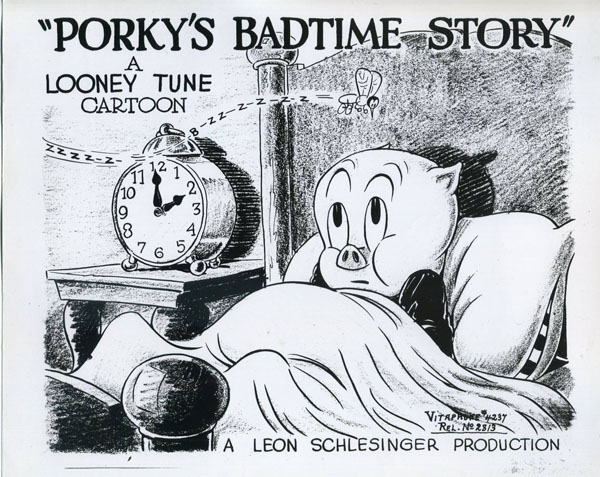
Born in 1913, Robert Emerson Clampett developed a fondness for drawing as an infant; he doodled with a pencil before he could walk. Engrossed by popular culture, Clampett’s artistic spark was fueled by the illustrations embedded in literary classics, silent cinema (“a wonderful world all its own,” as Clampett remembered fondly), and the color comics section of the Sunday newspaper. He learned to draw Frederick Opper’s Happy Hooligan, Rube Goldberg’s Boob McNutt, and Jiggs and Maggie from George McManus’ Bringing Up Father. Clampett would devise new continuities, writing and drawing events of his creation after their printed weekly installments. Soon, he studied the comic strips of Otto Messmer and Milt Gross, emulating their distinctive styles. Gross’ loose and frantic rendering of his characters appealed to the nascent Clampett, who sketched Nize Baby, Mr. Feitelbaum, and Looy Dot Dope for neighborhood kids on their sweatshirts and raincoats at the price of fifty cents to a dollar.
 In the summer of 1925, the twelve-year-old Clampett submitted cartoons to “The Junior Times,” an accompanying feature for young cartoonists in The Los Angeles Times. A crudely drawn but elaborate cover page detailing the adventures of a mischievous black housecat, titled “The Innocent Pussy,” caught the attention of powerful newspaper magnate William Randolph Hearst. With King Features’ promise of a contract after finishing school, Clampett worked in the art department of The Los Angeles Examiner on Saturdays and vacations. Furthermore, the Examiner agreed to fund his education at Otis Art Institute, where he learned oil painting and sculpture in Saturday classes for children. An ardent moviegoer, Clampett became interested in animation techniques by watching Felix the Cat on the theater screen. Curious about how Felix moved, Clampett visited the projection booth and requested to look at the reel. In turn, the projectionist clipped a section of the film reel (“a cycle walk or something”) and bestowed the sample to the junior high student. In 1927, Clampett filmed and completed a two-minute amateur film featuring him and his friends as actors entitled The Golf Widow. He brought the reel to Pacific Title and Art Studio for its intertitles, provided at no charge by its founder, Leon Schlesinger.
In the summer of 1925, the twelve-year-old Clampett submitted cartoons to “The Junior Times,” an accompanying feature for young cartoonists in The Los Angeles Times. A crudely drawn but elaborate cover page detailing the adventures of a mischievous black housecat, titled “The Innocent Pussy,” caught the attention of powerful newspaper magnate William Randolph Hearst. With King Features’ promise of a contract after finishing school, Clampett worked in the art department of The Los Angeles Examiner on Saturdays and vacations. Furthermore, the Examiner agreed to fund his education at Otis Art Institute, where he learned oil painting and sculpture in Saturday classes for children. An ardent moviegoer, Clampett became interested in animation techniques by watching Felix the Cat on the theater screen. Curious about how Felix moved, Clampett visited the projection booth and requested to look at the reel. In turn, the projectionist clipped a section of the film reel (“a cycle walk or something”) and bestowed the sample to the junior high student. In 1927, Clampett filmed and completed a two-minute amateur film featuring him and his friends as actors entitled The Golf Widow. He brought the reel to Pacific Title and Art Studio for its intertitles, provided at no charge by its founder, Leon Schlesinger.
Meanwhile, Clampett felt his creativity was better suited to sound cartoons and wanted to cancel his contract with King Features. He asked for a job at Disney’s studio after Clampett finished high school, which Walt agreed to. However, after organizing his samples using the Mickey Mouse comic strip as a reference, Clampett found that the position at Disney was unavailable due to a building expansion around the Hyperion studio. Desperate for a job in the animation business, Clampett took his sample drawings and walked to a studio on Hollywood Boulevard owned by ex-Disney artists Hugh Harman and Rudolf “Rudy” Ising in association with their producer Leon Schlesinger.
In 1931, the seventeen-year-old Clampett dropped out of high school to start working at Harman-Ising as an assistant animator to Larry Martin. The studio produced a series of Looney Tunes featuring Bosko. Bob arrived at a pivotal time, shortly after Leon Schlesinger signed for a second series of musical cartoons called Merrie Melodies for Warner Bros. On his second day working at Harman-Ising, Clampett animated crowd scenes in Lady Play Your Mandolin!, the first entry of the Merrie Melodies, but stuck to assisting after that. On that first week, Clampett participated in a story meeting for the second Merrie Melodie, Smile, Darn Ya, Smile! His suggestion involving advertisements coming to life in Foxy’s trolley car was approved and used in the final cartoon. Over the next two years at Harman-Ising, Clampett continued with assistant work and contributions to story conferences. Still, he preferred more creative control in developing stories and characters and yearned to become a director.

Young Bob Clampett at work
In 1933, Leon Schlesinger terminated his association with Harman and Ising and set up an animation studio on the Warner Bros. lot on Sunset Boulevard. Clampett was the first animator recruited to Schlesinger’s new studio as an assistant to Jack King, a recent transfer from Disney. Soon, more talent flocked to Schlesinger’s; Chuck Jones reported from Ub Iwerks’ studio to work as an assistant, and Friz Freleng left Harman-Ising, to become a director at the new Warners building. A year later, Clampett and Jones were promoted to full animators. They shared a private office on the second floor to produce more footage. Schlesinger then appointed them an assistant, Robert “Bobe” Cannon, or as Clampett nicknamed him, “Bobo.” However, the Looney Tunes and Merrie Melodies produced at Schlesinger’s new establishment did not provide a durable star character; their Looney Tunes headliner, Buddy, lacked charisma.
Schlesinger widened the opportunities for potential lead characters when he conceived a parody of Hal Roach’s Our Gang comedies with small animal children. With Freleng as director, Clampett helped develop the cast, which included a round pig and a black cat named Porky and Beans. This first cartoon with the menagerie of kids, I Haven’t Got a Hat, a Merrie Melodie released in 1935, had Porky struggling to recite Longfellow’s “The Midnight Ride of Paul Revere”—which later shifts to Tennyson’s “The Charge of the Light Brigade”—due to his persistent stammering. Porky’s stutter gave the character a sympathetic quality, differentiating from the falsetto voices used by Mickey Mouse and other talkie cartoon stars. However, Schlesinger envisioned Beans as the central character of the Looney Tunes. Therefore, Beans was the first of the “animal Our Gang” introduced in the opening cast titles of I Haven’t Got a Hat.

Gag drawing of Tex with Bob and Chuck, from November 1935. The drawing Tex displays makes reference to the title Plane Dippy, Tex’s second cartoon for Schlesinger’s and his first officially starring Porky.
During his time at Schlesinger’s, Clampett acquired the rights to Edgar Rice Burroughs’ John Carter of Mars novels, working on a sample film for “a whole year, nights and weekends,” with the help of Chuck Jones, Bobe Cannon, and Burroughs’ son John Coleman. On Sundays, Clampett shot the finished animation on cels in a building that specialized in photographing titles. Burroughs then took the demonstration reel to MGM for a potential Mars series. After MGM endorsed the John Carter project, Clampett resigned from Schlesinger’s, following the end of his three-year contract, and inaugurated the final storyboard of the first Mars production. Yet, after viewing the sample reel, MGM’s salespeople in the Midwest informed Burroughs that John Carter was not a sustainable property for audiences. Based on the success of the films starring Johnny Weismuller, MGM proposed a series of Tarzan cartoons. Clampett wasn’t compelled by this new arrangement, and Schlesinger enticed him with a new contract that promised a higher salary and a chance to direct when a position was vacant. In the fall of 1936, Leon assigned Clampett his first directorial job, an animated Technicolor segment caricaturing Zodiac signs for a Joe E. Brown feature, When’s Your Birthday?
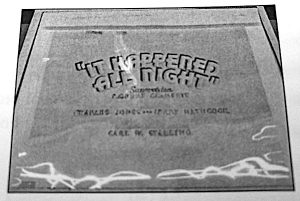
A rare glimpse at the original title card – replaced before release – for “It Happened All Night”. Note the inclusion of animator Jerry Hathcock, who is not credited on the final onscreen opening titles.
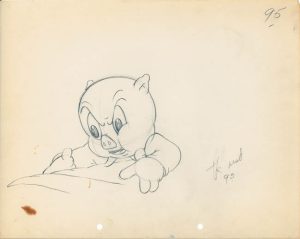 Animation on Badtime Story lasted three weeks, from April 6 to April 28, 1937. Besides Chuck Jones and Bobe Cannon, Iwerks animators Jerry Hathcock, Bill Hamner, and an artist listed in the production draft as “Tom”—possibly Tom Massey—each handled a large share of footage. Assistant animators from Schlesinger’s, John Carey (listed as “Jack” in the draft) and Lucifer “Lu” Guarnier, were assigned at least one scene in the cartoon; Carey later advanced as one of Clampett’s chief animators in his unit. Even Clampett devoted a lengthy sequence to animate himself: Porky tossing a shoe to silence a yowling catfight outside and the resulting shoes hurled back at him, recalling a similar routine involving a rubber horseshoe in Tex Avery’s The Village Smithy (1936). (When the final bombardment of shoes strikes Porky, the animation seems to switch from Clampett’s to Bill Hamner’s; this is not noted in the production draft but instead based on the drawing in scenes credited to Hamner throughout the film.)
Animation on Badtime Story lasted three weeks, from April 6 to April 28, 1937. Besides Chuck Jones and Bobe Cannon, Iwerks animators Jerry Hathcock, Bill Hamner, and an artist listed in the production draft as “Tom”—possibly Tom Massey—each handled a large share of footage. Assistant animators from Schlesinger’s, John Carey (listed as “Jack” in the draft) and Lucifer “Lu” Guarnier, were assigned at least one scene in the cartoon; Carey later advanced as one of Clampett’s chief animators in his unit. Even Clampett devoted a lengthy sequence to animate himself: Porky tossing a shoe to silence a yowling catfight outside and the resulting shoes hurled back at him, recalling a similar routine involving a rubber horseshoe in Tex Avery’s The Village Smithy (1936). (When the final bombardment of shoes strikes Porky, the animation seems to switch from Clampett’s to Bill Hamner’s; this is not noted in the production draft but instead based on the drawing in scenes credited to Hamner throughout the film.)
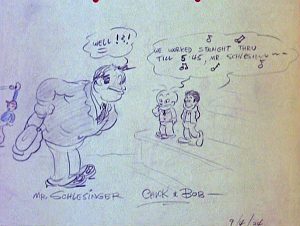
Gag drawing of Leon Schlesinger with Bob and Chuck, from 1934 – foreshadowing events in “Porky’s Badtime Story”
Jones’ following sequence occurs much later in the cartoon after an exhausted Porky, his bed now demolished, climbs into sleep next to Gabby. Due to a thunderstorm outside, droplets of water soak their blanket from a leak in their ceiling. Gabby notices the sudden dampness on their sheets and awakens; he looks down at the puddle and then points his head to Porky, believing he is the culprit. Then, he looks at the bedding again before eliciting a disgusted look at the camera until another droplet lands on Gabby. (Bodily function humor was prevalent in Iwerks’ cartoons, too; in 1932’s The Milkman, Flip the Frog suspects a particular wetness as the source of a street urchin boy’s crying when he inspects the bottom of their shorts.)
 Chuck’s animation continues when Gabby opens an umbrella to prevent more “water on the brain,” maintaining his offended expression. Finally, after Porky informs him of bringing bad luck, Gabby scowls at his friend in incredulous displeasure before Gabby dismisses it as superstition. This brief moment of slightly exaggerated but subtle human emotions became Jones’ forte as a director when making precise details on the most suitable facial expression for his character, depending on their circumstances on-screen.
Chuck’s animation continues when Gabby opens an umbrella to prevent more “water on the brain,” maintaining his offended expression. Finally, after Porky informs him of bringing bad luck, Gabby scowls at his friend in incredulous displeasure before Gabby dismisses it as superstition. This brief moment of slightly exaggerated but subtle human emotions became Jones’ forte as a director when making precise details on the most suitable facial expression for his character, depending on their circumstances on-screen.
By the time Badtime was in production, musical director Carl Stalling had been the composer of Schlesinger’s cartoons for only a year. Formerly associated with Walt Disney and Ub Iwerks, respectively, Stalling bolstered the soundtracks of the Looney Tunes and Merrie Melodies, incorporating popular music connected by small bridges of original compositions. After the storyboards were approved, Clampett transported the finished panels to Stalling’s music room, gesticulating the characters’ actions, while conveying the appropriate tempos and mood in the accompanying music throughout the cartoon. In Badtime, a mixture of contemporary tunes from the period, primarily songs owned by Warners, are implemented throughout.
Stalling bookends the cartoon with Dave Franklin and Cliff Friend’s “When My Dreamboat Comes Home,” first used in a soothing orchestration when Porky and Gabby are asleep in their beds, ignoring their alarm to rise at six o’clock. Then, after the two realize they have overslept and are late for their jobs, the song plays with urgency, appropriately matching Porky and Gabby’s rush to work. During the three set pieces, each involving a nuisance interrupting Porky and Gabby’s slumber, Stalling accompanies them with three consecutive songs. Clampett’s sequence of Porky continuously hurling a shoe out of the window is underscored by “How Could You,” by songwriting duo Al Dubin and Harry Warren, from the Warners feature San Antonio. The old standard by Gus Edwards and Edward Madden, “By the Light of the Silvery Moon,” aptly plays during Porky’s struggle with a stubborn window shade to cover a beaming moonlight. Lastly, when the rain droplets disturb Gabby Goat, another Al Dubin-Harry Warren song is appropriately utilized: “September in the Rain”, introduced in Melody for Two.

Production cel set-up, courtesy of the Mike and Jeanne Glad Collection.
Three months after animation started on Badtime, the cartoon was released to theaters on July 24, 1937. Seven years later, Schlesinger’s studio released Tick Tock Tuckered (1944), a remake of Clampett’s inaugural film, now pairing Porky with Daffy Duck. In the span between both films, his work improved significantly after he inherited Tex Avery’s unit following Avery’s departure in 1941.
 Tick Tock Tuckered has minimal deviations from the original Badtime Story. For instance, Porky and Daffy’s new occupation as defense workers for an aircraft company provides a substitute for the Peter Piper Pickled Peppers building in Clampett’s earlier version—reflecting the impact of World War II. Two inside references to Schlesinger’s studio appear in Tuckered when Porky and Daffy’s boss, a direct caricature of Ray Katz, condescendingly nicknames them “the Dover Boys,” after Jones’s cartoon released at least a year before.
Tick Tock Tuckered has minimal deviations from the original Badtime Story. For instance, Porky and Daffy’s new occupation as defense workers for an aircraft company provides a substitute for the Peter Piper Pickled Peppers building in Clampett’s earlier version—reflecting the impact of World War II. Two inside references to Schlesinger’s studio appear in Tuckered when Porky and Daffy’s boss, a direct caricature of Ray Katz, condescendingly nicknames them “the Dover Boys,” after Jones’s cartoon released at least a year before.
Tuckered enhances Badtime’s moonlight sequence in its conclusion: annoyed by its luminescence, Daffy shoots at the moon with a rifle, which quickly drops from the sky, as animated by Rod Scribner. At the end of Badtime, after Porky and Gabby hurry back home to sleep, Porky smacks their alarm clock with a hammer to silence, which leaves it dizzy; Clampett also animated this final scene. In Tuckered, however, like Daffy disposing of the moon with firearms, Porky uses a shotgun to blast the alarm clock. Furthermore, to minimize costs, Clampett reused animation from Friz Freleng’s Notes to You (1941), when Porky flings a book entitled “The Falcon” out of his window, only to have its sequel “The Falcon Returns” launched back at him.

Comparison frames from “Porky’s Bedtime Story” on the left, with its remake “Tick Tock Tuckered” on the right
In an interview, Clampett recalled that after viewing the “dailies” for Badtime, he requested minor adjustments in editing his first picture. Schlesinger’s brother-in-law/business manager Ray Katz approved the changes and allowed selected scenes for reshooting—a rare privilege, given the limited budgets of Leon’s studio. After the animation on Badtime finished, Clampett put his second cartoon in production, Get Rich Quick Porky, the last pairing of Porky and Gabby.

12/14/2024 update: A rare discovery: a worksheet for BADTIME STORY in a format different from the usual Schlesinger papers. We believe this is the Iwerks studio draft form. Clampett remembered that he was appointed director “one Monday morning“. Since April 12, 1937 (the animation finish date on the sheet) fell on a Monday, this could be when Clampett took over direction. The artist credited as “Ray” is Ray Fahringer; his scenes were reassigned to Bill Hamner, reflected in the “final” production draft below.

Notes on the reverse side of the Iwerks studio draft.


Appendix: The production draft for Badtime Story indicates that scenes 26 and 27 were eliminated. An exposure sheet for scene 26 reveals a planned but discarded fifteen-foot sequence (ten seconds) involving a mosquito twisting a sharp bit into his proboscis like a drill and targeting the unsuspecting Porky’s head. Unfortunately, the second exposure sheet, notating the continuing action of the same shot, cuts off the bottom of the document.

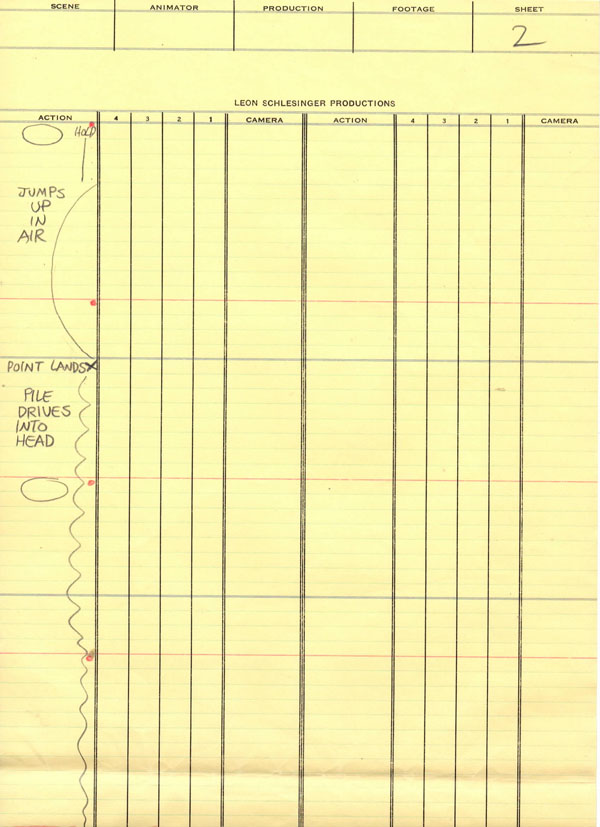
The production draft for Badtime does not contain scene descriptions; the animator credits are listed by number. Recently, animator breakdowns of two 1939 Clampett films, Jeepers Creepers and Polar Pals, have been published on my Patreon page at the $3+ level. Another inclusion is the iconic 1965 holiday staple A Charlie Brown Christmas, previously posted two years ago but is now offered on the same tier. Consider subscribing if you would like to see them!

(Thanks to Jerry Beck, Ruth Clampett, Michael Barrier, Milt Gray, and Mark Kausler for the sources used for the post.)



 DEVON BAXTER is a film restoration artist, video editor, and animation researcher/writer currently residing in Pennsylvania. He also hosts a
DEVON BAXTER is a film restoration artist, video editor, and animation researcher/writer currently residing in Pennsylvania. He also hosts a 





















































































Fifty cents to a dollar seems like an awful lot of money for a kid in the 1920s to spend on having another kid decorate his clothes with pictures of cartoon characters. But then, Clampett did grow up in Hollywood.
During the scene where the time clock sounds an alarm and the boss talks to Porky and Gabby, we hear a passage from the first movement of Schubert’s famous Unfinished Symphony. It’s unusual for Stalling to quote from this piece; he was generally more partial to Mendelssohn.
In the 1957 cartoon “Boo Bop”, Casper the friendly ghost helps the ghost of Franz Schubert complete his Unfinished Symphony. By coincidence, the passage that Casper comes up with is the very same one quoted by Stalling in “Porky’s Badtime Story”.
Then there was an episode of The Simpsons where the Springfield Elementary School band played the Unfinished Symphony. Homer is delighted by the word “unfinished”, as he wants to go to a monster truck rally after the concert; but as the symphony drags on, he grumbles: “How much longer was Sherbert planning on making this?”
Nice job Devon!
Devon, I didn’t recall Tom Massey’s name before this. I see he was at Disney in 1940. In 1930, he was living in Los Angeles but his occupation was “helper” on a transfer truck. He was born July 11. 1909 in Denver and died May 6, 1997 in L.A.
Fantastic work, Devon. Now if someone can figure out why the whole cartoon looks like it was shot out of focus (even the remastered version on HBO Max), I’ll be really impressed.
I remember this cartoon.
Glad to see Tails fans on Cartoon Research!
Super! Thanx Devon.
Great post, Devon! At last I’ve learned the name of the animator who is the most “Iwerks” of the Clampett unit, Bill Hamner. He really drew the characters his own way, and used graphics that would be at home in a silent cartoon, like the little question marks that emerge from Porky and Gabby’s heads when they encounter the “Closed Sunday” sign at the pickled pepper factory. Is the draft complete? The second page doesn’t seem to match up to your breakdown video, as Bob Clampett animated the last scene in the cartoon and the draft only goes up to sc 54, which is credited to Jerry Hathcock. Thanks again for sharing the draft and your insights into Clampett’s first Looney Tune!
Mark – This is the whole draft (unfortunately ripped in half due to age). Note that scenes 55 through 65 are on the upper top right of the sheet.
In some ways, the best part of this essay is the selection of in-house gag cartoons. I’ve not seen any of the ones posted in the essay, which made it enjoyable. Where, exactly, did that original title card come from?
So Chuck Jones animated the guy who calls Porky and Gabby “the Rover Boys”.
Then he directed the cartoon which parodies the original Rover Boys, called “The Dover Boys”.
Then Bob Clampett referenced Jones’ cartoon when he remade this one, as the equivalent character now calls Porky and Daffy “the Dover Boys”.
Surprised to see Lu Guarnier animating a scene here when he didn’t animate anything (and I assumed he was still an assistant) on “Get Rich Quick Porky” (also surprised to see his name appear as “LUCIFER” on the draft!). Also surprised that Norm McCabe doesn’t seem to have animated on “Badtime Story” (maybe he was still in Tashlin’s unit?).
I like Tick Tock a lot better. Color Clampett’s a lot more fun!
Clampett’s color cartoons are technically superior but I would easily place Porky in Wackyland among his finest works.
Clampett’s early Porky shorts (around 1937-39) have this unique charm to them. It’s clearly Bob and his young crew seeing what they can do together and doing what they themselves thought was funny. “Porky’s Hero Agency” and “Porky’s Five & Ten” are among my faves from this era.
Young Bob Clampett was quite pretty, as was young Shamus Culhane. Neither aged well, but at least Culhane didn’t wear a wig.
Neither did Clampett. It look like he was wearing a toipee but he wasn’t.
Agreed. Young Bob was quite the looker and so was Chuck!
Fantastic work as always, Devon! I really enjoyed seeing the original title card in particular. I had no idea the title got as far as artwork done for it!
Interesting that the original name for the short got as far as getting a cel made for it. In that case, I wonder if it ever made it to a workprint… It’s also fascinating to see that Jerry Hathcock was to get a credit. (It’s also slightly amusing to me to see the names “Tom” and “Jerry” right under each other on the second half of the draft!)
I’ve always really liked Jones’ animation style in this era, the very smooth way he makes everyone move is appealing to me. Bill Hamner’s far looser take on the characters is also charming. Looking forward to seeing more Clampett archive rarities!